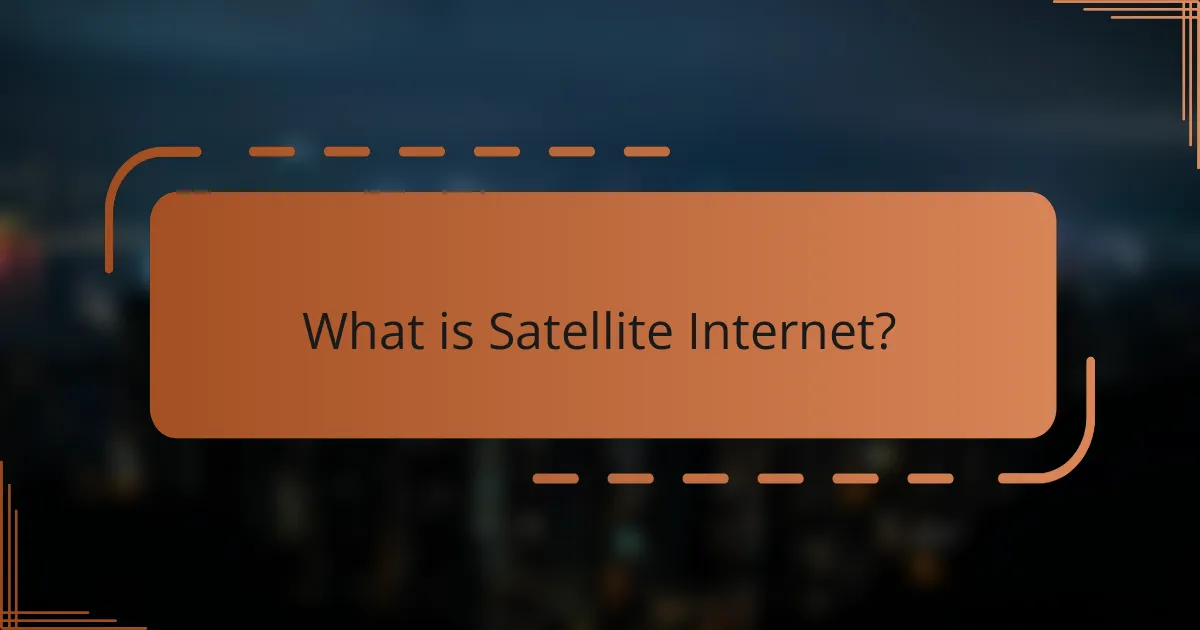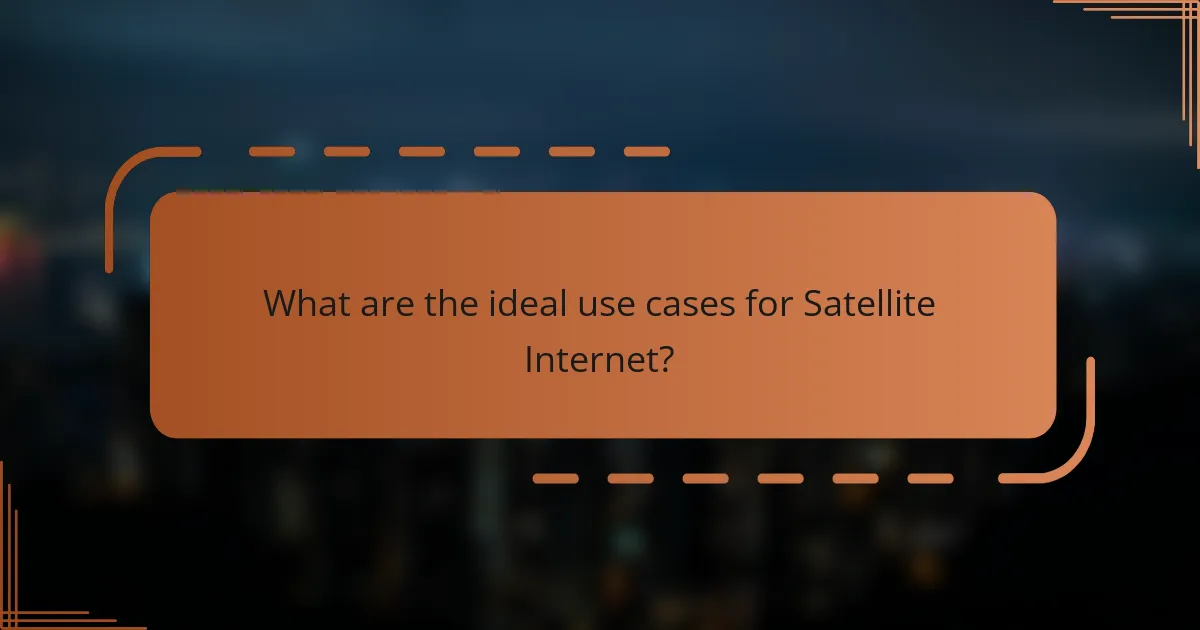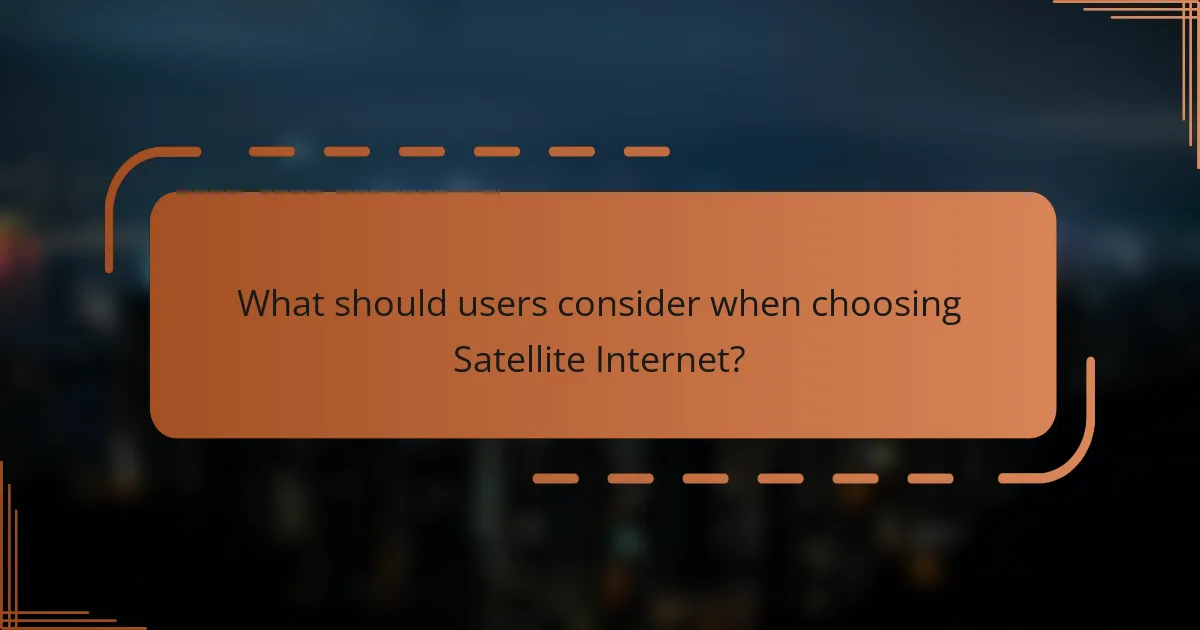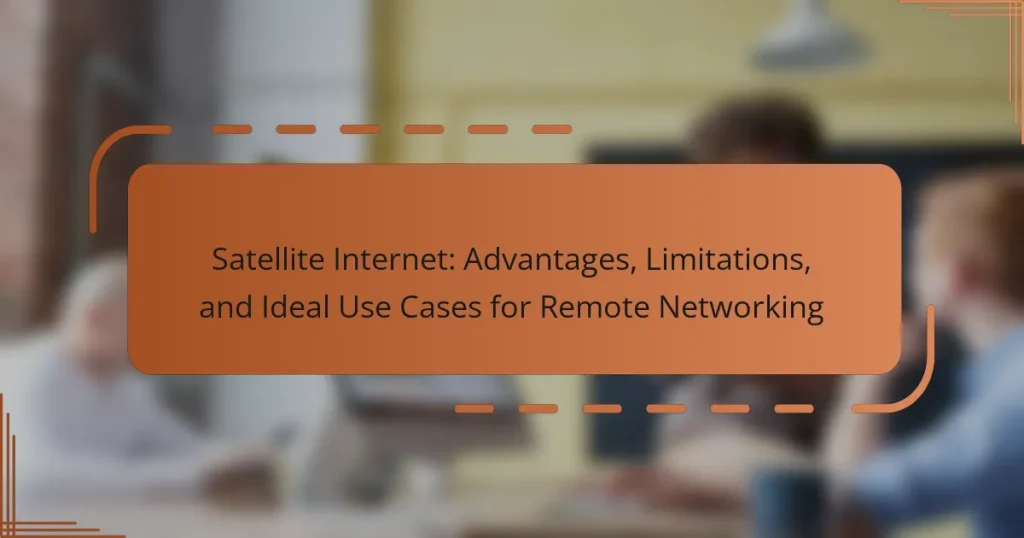Satellite Internet is a technology that provides internet access through satellites orbiting the Earth, enabling connectivity in remote and rural areas where traditional broadband is unavailable. This service typically requires a satellite dish to transmit and receive data, with download speeds ranging from 12 Mbps to 100 Mbps. Ideal use cases for Satellite Internet include supporting underserved communities, facilitating education and telemedicine, and providing connectivity for maritime and aviation industries. However, users should be aware of potential limitations such as latency, data caps, and service reliability, as well as the importance of installation costs and customer support. The article will explore the advantages, limitations, and specific scenarios where Satellite Internet is most beneficial for remote networking.

What is Satellite Internet?
Satellite Internet is a type of internet connection that uses satellite technology to provide access. It transmits data to and from a satellite orbiting the Earth. This technology enables internet access in remote and rural areas where traditional broadband is unavailable. Satellite Internet typically involves a satellite dish installed at the user’s location. The dish communicates with a satellite that relays the signal to ground stations. Speeds can vary, but many services offer download speeds ranging from 12 Mbps to 100 Mbps. According to the Federal Communications Commission (FCC), satellite internet can be a vital solution for underserved communities.
How does Satellite Internet work?
Satellite Internet works by transmitting data from a user’s satellite dish to a satellite in orbit. This satellite then relays the data to a ground station connected to the internet. The process involves two main components: the satellite and the ground infrastructure. The satellite orbits the Earth at a fixed point, usually around 22,236 miles above the equator. It receives signals from the user’s dish and sends them back to the ground station. The ground station processes these signals and connects to the broader internet network. This system allows users in remote areas to access the internet where traditional connections may not be available. Satellite Internet typically has higher latency due to the long distance the signals must travel. However, it provides coverage in areas lacking terrestrial infrastructure.
What are the key components of Satellite Internet technology?
The key components of Satellite Internet technology include satellites, ground stations, and user terminals. Satellites orbit the Earth and facilitate data transmission. Ground stations send and receive signals to and from the satellites. User terminals are the devices used by consumers to access the internet via the satellite signals. Each satellite typically covers a specific geographic area, known as a footprint. The technology operates on different frequency bands, such as Ku-band and Ka-band, which affect bandwidth and signal quality. Satellite Internet can provide connectivity in remote areas where traditional broadband is unavailable, making it essential for rural and underserved regions.
How do satellites communicate with ground stations?
Satellites communicate with ground stations using radio waves. Ground stations transmit signals to satellites, which then relay information back to Earth. This process involves various frequencies to ensure effective communication. Satellites utilize transponders to receive, amplify, and retransmit signals. The communication occurs in different bands, such as Ku-band or Ka-band, which are optimized for data transmission. Line of sight is essential for this communication, as obstacles can disrupt signals. The technology enables services like satellite internet, broadcasting, and weather monitoring. These systems are critical for global connectivity, especially in remote areas.
What are the main advantages of Satellite Internet?
Satellite Internet offers high-speed connectivity in remote areas. It provides access where traditional broadband is unavailable. Satellite Internet is not limited by geographical barriers. It can reach rural and underserved communities effectively. The service is typically easy to set up with minimal infrastructure. Users can experience consistent speeds regardless of local network congestion. Satellite Internet can support multiple devices simultaneously. It is often available globally, making it a versatile option for travelers.
How does Satellite Internet provide global coverage?
Satellite Internet provides global coverage by utilizing satellites in geostationary or low Earth orbit. These satellites transmit signals to ground stations and user terminals. The geostationary satellites orbit at approximately 22,236 miles above the Earth. They maintain a fixed position relative to the Earth’s surface, allowing for consistent communication. Low Earth orbit satellites operate at altitudes ranging from 100 to 1,200 miles. They require a network of satellites to ensure coverage, as they move relative to the Earth.
The signals from satellites can reach remote and rural areas where traditional internet infrastructure is lacking. For example, companies like SpaceX with their Starlink project deploy thousands of low Earth orbit satellites to enhance coverage. This network can provide internet access to users worldwide, even in underserved regions. Satellite Internet can connect users in areas with challenging terrain, such as mountains or oceans. This capability makes it a vital solution for global connectivity.
What speed and bandwidth can users expect from Satellite Internet?
Users can expect speeds from 12 Mbps to 100 Mbps with Satellite Internet. Bandwidth can vary based on the provider and plan selected. For example, providers like HughesNet offer plans with speeds up to 25 Mbps. Viasat can provide speeds up to 100 Mbps in certain areas. Latency typically ranges from 500 ms to 700 ms due to the distance signals must travel to satellites. This can affect real-time applications like gaming and video conferencing. Overall, Satellite Internet is suitable for browsing and streaming but may have limitations for high-demand usage.
What limitations does Satellite Internet have?
Satellite Internet has several limitations. One major limitation is high latency. Latency can reach 600 milliseconds or more due to the distance signals must travel to satellites. This can hinder real-time applications like video calls and online gaming.
Another limitation is data caps. Many satellite providers impose monthly data limits, which can lead to throttling speeds once exceeded. This restricts heavy usage activities such as streaming or large downloads.
Additionally, weather conditions can affect connectivity. Rain, snow, or heavy cloud cover can disrupt signals, leading to slower speeds or outages.
Cost is also a concern. Satellite Internet tends to be more expensive than other broadband options, both in monthly fees and equipment costs.
Lastly, availability may be limited. While satellite coverage is widespread, some rural areas may still experience service limitations or lack of options.
How does latency affect Satellite Internet performance?
Latency significantly affects Satellite Internet performance by introducing delays in data transmission. Satellite Internet relies on signals traveling to and from satellites in orbit. This distance results in higher latency compared to terrestrial connections. Typical latency for satellite connections ranges from 500 milliseconds to 1 second.
High latency can cause noticeable delays in activities like video conferencing and online gaming. It can also lead to slower page loading times and interruptions in streaming services. These delays occur because data must travel to the satellite and back to Earth.
Research indicates that latency can impact user experience, particularly in real-time applications. Users may experience lag, which can hinder effective communication and interaction. Therefore, understanding latency is crucial for optimizing Satellite Internet performance in various applications.
What are the challenges of weather interference with Satellite Internet?
Weather interference poses significant challenges for Satellite Internet. Rain, snow, and heavy cloud cover can disrupt signal quality. This phenomenon is known as “rain fade.” It occurs when raindrops absorb and scatter the satellite signals. Snow accumulation on satellite dishes can block signals entirely. Additionally, thunderstorms can introduce turbulence and signal degradation. These weather conditions can lead to slower internet speeds and increased latency. Research indicates that severe weather can reduce satellite signal strength by up to 50%. Thus, users may experience intermittent connectivity during adverse weather.

What are the ideal use cases for Satellite Internet?
Ideal use cases for Satellite Internet include remote areas lacking terrestrial infrastructure. These locations often experience limited or no access to traditional broadband services. Satellite Internet provides connectivity in rural regions, enabling essential services like education and telemedicine. It is also beneficial for maritime and aviation industries, offering internet access while at sea or in the air. Disaster recovery efforts utilize Satellite Internet for immediate communication when terrestrial networks are down. Additionally, it supports IoT applications in agriculture and environmental monitoring in remote locations. According to the Federal Communications Commission (FCC), over 19 million Americans lack access to broadband, highlighting the need for satellite solutions.
How is Satellite Internet beneficial for remote areas?
Satellite Internet provides essential connectivity for remote areas lacking traditional broadband infrastructure. It enables users to access the internet from virtually anywhere, overcoming geographical barriers. Satellite technology allows for high-speed data transmission, even in isolated locations. This service supports various applications, including telemedicine, remote education, and business operations. According to the Federal Communications Commission (FCC), satellite internet can reach speeds of up to 100 Mbps, making it viable for many online activities. Additionally, it offers reliable service during emergencies when terrestrial networks may fail. The availability of satellite internet fosters economic growth and social inclusion in underserved regions.
What industries rely on Satellite Internet for connectivity?
Several industries rely on Satellite Internet for connectivity. These include maritime, aviation, agriculture, oil and gas, and emergency services. Maritime industries use satellite connections for navigation and communication at sea. Aviation relies on satellite Internet for in-flight connectivity and operational data transmission. Agriculture benefits from satellite Internet for precision farming and remote monitoring of crops. The oil and gas sector utilizes satellite connections for remote site communication and data transfer. Emergency services depend on satellite Internet for reliable communication in disaster-stricken areas where terrestrial networks are unavailable.
How does Satellite Internet support emergency response efforts?
Satellite Internet supports emergency response efforts by providing reliable communication in disaster-stricken areas. It enables first responders to maintain connectivity when terrestrial networks fail. Satellite connections can be quickly deployed, often within hours of a disaster. This rapid deployment is crucial for coordinating rescue operations and delivering aid.
Moreover, Satellite Internet offers coverage in remote locations where traditional infrastructure is lacking. During emergencies, it facilitates real-time data sharing, which is essential for decision-making. For instance, satellite imagery can help assess damage and plan recovery efforts.
Studies show that during Hurricane Katrina, satellite communication was vital for emergency coordination. Organizations like FEMA utilized satellite technology to enhance their response capabilities. Therefore, Satellite Internet is an essential tool for effective emergency management and disaster response.
What are the specific applications of Satellite Internet in various sectors?
Satellite Internet is used in various sectors for reliable connectivity. In agriculture, it supports precision farming through data collection and analysis. Telemedicine relies on satellite connections for remote consultations and diagnostics. The maritime industry uses satellite Internet for navigation and communication at sea. In education, it provides access to online resources in remote areas. Emergency services utilize satellite connectivity for coordination during disasters. The energy sector employs it for monitoring remote facilities and equipment. Finally, the military uses satellite Internet for secure communications and operational coordination.
How does Satellite Internet enhance telemedicine services?
Satellite Internet enhances telemedicine services by providing high-speed connectivity in remote areas. This technology enables healthcare professionals to conduct virtual consultations with patients regardless of location. It facilitates real-time data transmission, which is crucial for remote diagnostics and monitoring. Satellite Internet supports video conferencing, allowing doctors to visually assess patients. It also ensures access to electronic health records, improving the quality of care. According to the Federal Communications Commission (FCC), satellite Internet can reach underserved populations where traditional broadband is unavailable. This connectivity helps bridge the gap in healthcare access, especially in rural and isolated regions.
What role does Satellite Internet play in education and e-learning?
Satellite Internet provides essential connectivity for education and e-learning, especially in remote areas. It enables students and educators to access online resources and digital learning platforms. This technology supports video conferencing and real-time collaboration among students and teachers. According to a report by the International Telecommunication Union, over 3.5 billion people lack internet access, making satellite solutions crucial for bridging this digital divide. Satellite Internet also allows for the delivery of educational content in areas where traditional broadband is unavailable. Reliable satellite connections can facilitate distance learning programs, enhancing educational opportunities for underserved populations.

What should users consider when choosing Satellite Internet?
Users should consider latency, data caps, and service reliability when choosing Satellite Internet. Latency in satellite connections can be higher than terrestrial options, affecting real-time applications. Data caps may limit usage, impacting streaming and large downloads. Service reliability can vary based on weather conditions, which may disrupt connectivity. Additionally, users should evaluate the installation costs and equipment needed for service. Finally, reviewing customer service and support options is essential for troubleshooting any issues.
What factors influence the selection of a Satellite Internet provider?
Key factors influencing the selection of a Satellite Internet provider include service availability, speed, data limits, and cost. Service availability determines if the provider covers a specific geographic area. Speed affects the performance of online activities, with higher speeds enabling better streaming and downloads. Data limits can restrict usage, impacting heavy internet users. Cost includes installation fees and monthly charges, which vary among providers. Customer support quality is also crucial, as reliable assistance can enhance user experience. Finally, equipment options and installation processes may influence provider choice, especially for users with specific technical needs.
How do pricing and service plans vary among providers?
Pricing and service plans for satellite internet vary significantly among providers. Different companies offer various pricing tiers based on speed, data limits, and contract length. For example, some providers may charge $50 to $150 per month for plans with speeds ranging from 12 Mbps to 100 Mbps. Data caps typically range from 10 GB to unlimited, impacting overall costs. Installation fees can also differ, with some providers offering free installation and others charging up to $200. Additionally, promotional rates may be available for the first year, increasing after the initial contract period. Customer service quality and additional features like equipment rental can further influence the overall value of each plan.
What performance metrics should users evaluate?
Users should evaluate latency, download speed, upload speed, and data caps when assessing satellite internet performance. Latency measures the delay in data transmission, typically ranging from 500 ms to 700 ms for satellite connections. Download speed indicates how quickly data is received, often between 12 Mbps to 100 Mbps depending on the service provider. Upload speed reflects how fast data can be sent, usually lower than download speeds, often around 3 Mbps to 25 Mbps. Data caps limit the amount of data that can be used in a billing cycle, which can affect overall service quality. Evaluating these metrics helps users determine the suitability of satellite internet for their needs.
What tips can help optimize the use of Satellite Internet?
To optimize the use of Satellite Internet, position the satellite dish with a clear view of the sky. Avoid obstructions like trees and buildings that can block the signal. Regularly check and tighten connections to prevent signal loss. Use a wired connection for devices when possible, as it offers better stability than Wi-Fi. Limit the number of connected devices to reduce bandwidth competition. Schedule large downloads during off-peak hours for faster speeds. Update equipment and firmware to ensure optimal performance. Monitor data usage to avoid throttling from service providers.
How can users troubleshoot common Satellite Internet issues?
Users can troubleshoot common Satellite Internet issues by following these steps. First, check the satellite dish alignment. Misalignment can significantly affect signal quality. Second, inspect all cables for damage or loose connections. Damaged cables can disrupt connectivity. Third, reboot the satellite modem and router. This can resolve temporary connectivity issues. Fourth, verify the service status with the provider. Outages can occur due to maintenance or severe weather. Fifth, limit obstructions around the satellite dish. Trees or buildings can block signals. Lastly, check for software updates on the modem and router. Updated firmware can improve performance and stability.
What best practices enhance the reliability of Satellite Internet connections?
To enhance the reliability of Satellite Internet connections, users should ensure a clear line of sight to the satellite. Obstructions like trees or buildings can significantly degrade the signal quality. Regularly checking and adjusting the satellite dish alignment is crucial. A misaligned dish can lead to intermittent connectivity issues.
Using high-quality equipment, such as routers and modems designed for satellite use, can improve performance. These devices often have features that optimize satellite connections. Additionally, implementing a backup connection can provide redundancy. In case of satellite service disruption, an alternative connection can maintain internet access.
Monitoring weather conditions is also important. Heavy rain or storms can impact satellite signals. Users should be aware of potential outages during severe weather events. Finally, limiting the number of connected devices can help maintain bandwidth availability. Fewer devices reduce competition for the available bandwidth, leading to a more stable connection.
Satellite Internet is a technology that provides internet access via satellite communication, primarily serving remote and rural areas where traditional broadband is unavailable. The article covers its operational mechanics, including the roles of satellites, ground stations, and user terminals, while discussing the advantages such as high-speed connectivity and global coverage. It also addresses limitations like high latency, data caps, and weather interference, and highlights ideal use cases across various sectors, including telemedicine, education, and emergency services. Additionally, the article offers guidance on selecting providers, evaluating performance metrics, and optimizing satellite internet usage.


